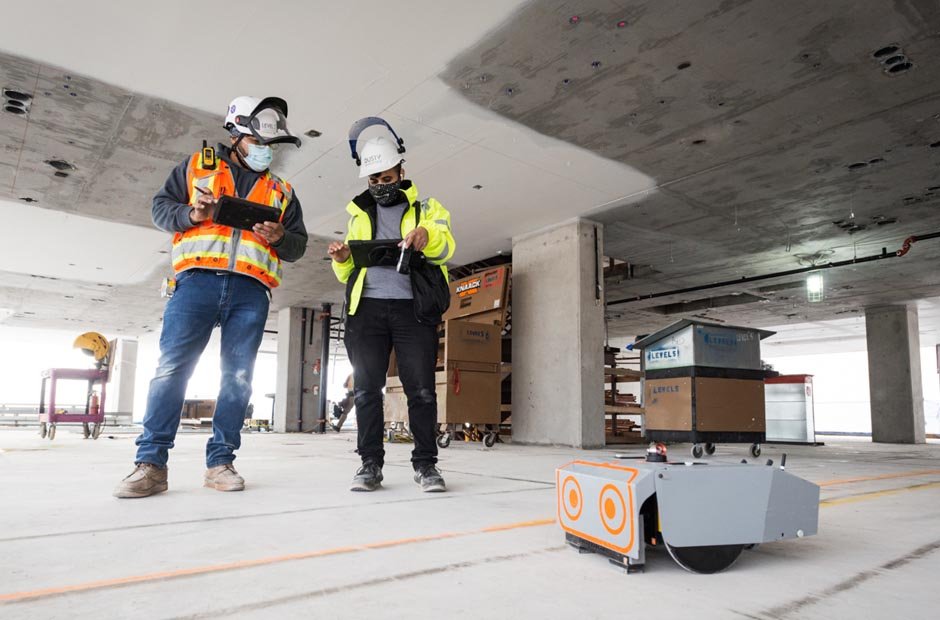The construction industry has embarked on a transformative journey, harnessing cutting-edge technology to achieve unprecedented precision, efficiency, and productivity. Construction layout robots (CLRs), commonly known as “robots” in the industry, are at the forefront of this technological revolution. And with this rapidly evolving construction landscape, the question of “how are robots used in construction?” looms large.
These robotic marvels have emerged as key players in construction, revolutionizing how structures are designed and built. They embody progress, seamlessly integrating into construction sites and taking on crucial tasks that were once solely human endeavors. This article focuses on exploring the multifaceted world of CLRs, from their role in construction to the factors influencing their performance and the strategies employed to optimize their efficiency.
Construction Layout Robots
Construction layout robots (CLRs) are remarkable robotic systems designed to streamline the process of accurately setting out locations for structural elements on construction sites. Their tasks encompass marking foundation corners, positioning anchor bolts, and laying out walls with unparalleled precision. CLRs have become indispensable tools in the construction industry, significantly reducing errors, increasing overall productivity, and saving valuable time.
Measuring the Efficiency of CLRs
One of the most common metrics used in assessing CLR performance is the “accuracy rate.” This metric is reliable, measuring how closely the robot’s layout aligns with the planned design. A high accuracy rate indicates superior CLR performance; in the construction industry, an accuracy rate of 98% or higher is deemed exceptional. This measurement allows construction professionals to ensure that their projects adhere to the intended specifications with minimal discrepancies.
Factors Affecting CLR Performance
Several critical factors influence CLR performance:
Environmental Conditions: Extreme weather conditions can profoundly impact CLR operations. Heavy rain, strong winds, or extreme temperatures can disrupt the robot’s functionality by affecting its sensors and mobility. Navigating through adverse weather conditions is a significant challenge for CLRs.
Terrain and Site Conditions: Construction sites often present uneven terrain, debris, and obstacles. CLRs must be equipped to navigate and adapt to these ever-changing site conditions. Their ability to operate effectively on challenging terrains can significantly affect overall performance.
Software and Programming: The software and programming that govern CLR operations are integral to their performance. Regular updates and meticulous software maintenance are essential to keep the robot operating optimally. These updates may involve fine-tuning algorithms and continually incorporating new features to enhance performance.
Battery Life: It is a vital consideration for CLR efficiency. Inadequate battery life can result in downtime and disruptions to the construction schedule. Implementing effective battery management systems, such as quick-charging stations or swappable batteries, is essential to maximize the CLR’s working hours.
Sensor Calibration: Accurate sensor calibration is fundamental to CLR precision. Regular calibration ensures that the robot’s sensors are in optimal working condition, allowing it to perform tasks accurately. Sensor calibration should be part of routine maintenance to maintain peak performance.
Optimizing CLR Performance
To optimize CLR performance, consider these strategies:
Regular Maintenance: CLRs, like any machinery, require routine maintenance to operate reliably. This maintenance includes cleaning, lubrication, and thorough inspections. Identifying and addressing potential issues early through maintenance can prevent disruptions in construction projects.
Upgraded Sensors: Investing in advanced sensors can significantly enhance CLR performance. These sensors enable the robot to navigate complex terrains and adapt to changing environmental conditions more effectively. Upgrading sensors can make the CLR a more versatile and adaptable tool on construction sites.
Improved Software: Continuous software updates and enhancements are vital for keeping CLR programming up-to-date and efficient. This process may involve refining algorithms, incorporating new features, and addressing software-related issues. Keeping the software optimized ensures that the CLR can execute tasks accurately and efficiently.
Battery Management: Effective battery management is crucial to minimize downtime and maximize the CLR’s operational hours. Quick-charging stations and swappable batteries can ensure that the robot remains powered throughout the workday, increasing productivity.
Training and Certification: Ensuring construction site personnel are well-trained in CLR operation is essential. Certification programs help guarantee that these robots are used correctly, further optimizing their performance. Proper training minimizes errors and maximizes the efficiency of CLR deployment.
Data Analysis: Collecting and analyzing data on CLR performance provides valuable insights into areas for improvement. Adjustments can be made to enhance overall performance by identifying patterns of inefficiency or errors. Data analysis is an invaluable tool in the ongoing optimization of CLR operations.
Conclusion
In conclusion, the question of “how are robots used in construction?” is met with a resounding response – with innovation, precision, and efficiency. Construction layout robots (CLRs) have found their place on construction sites and etched their mark as indispensable tools in the modern construction industry.
As technology advances, CLRs will play an increasingly pivotal role in construction, enhancing productivity, minimizing errors, and accelerating project timelines. Their ability to perform tasks with remarkable precision, even in challenging environments, has transformed how we approach construction.
By addressing the factors influencing CLR performance and embracing optimization strategies, construction professionals can ensure that these robots continue contributing to safer, faster, and more accurate construction processes. In this dynamic landscape, the synergy between human expertise and robotic precision is a testament to the industry’s commitment to progress, setting the stage for a future where construction is defined by innovation and excellence.
















